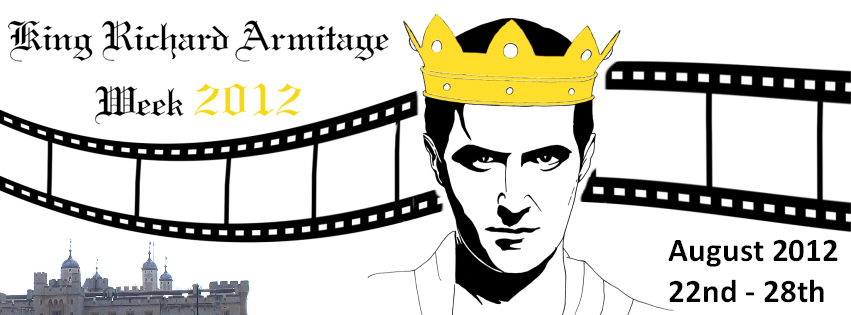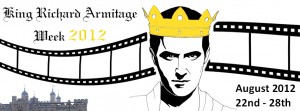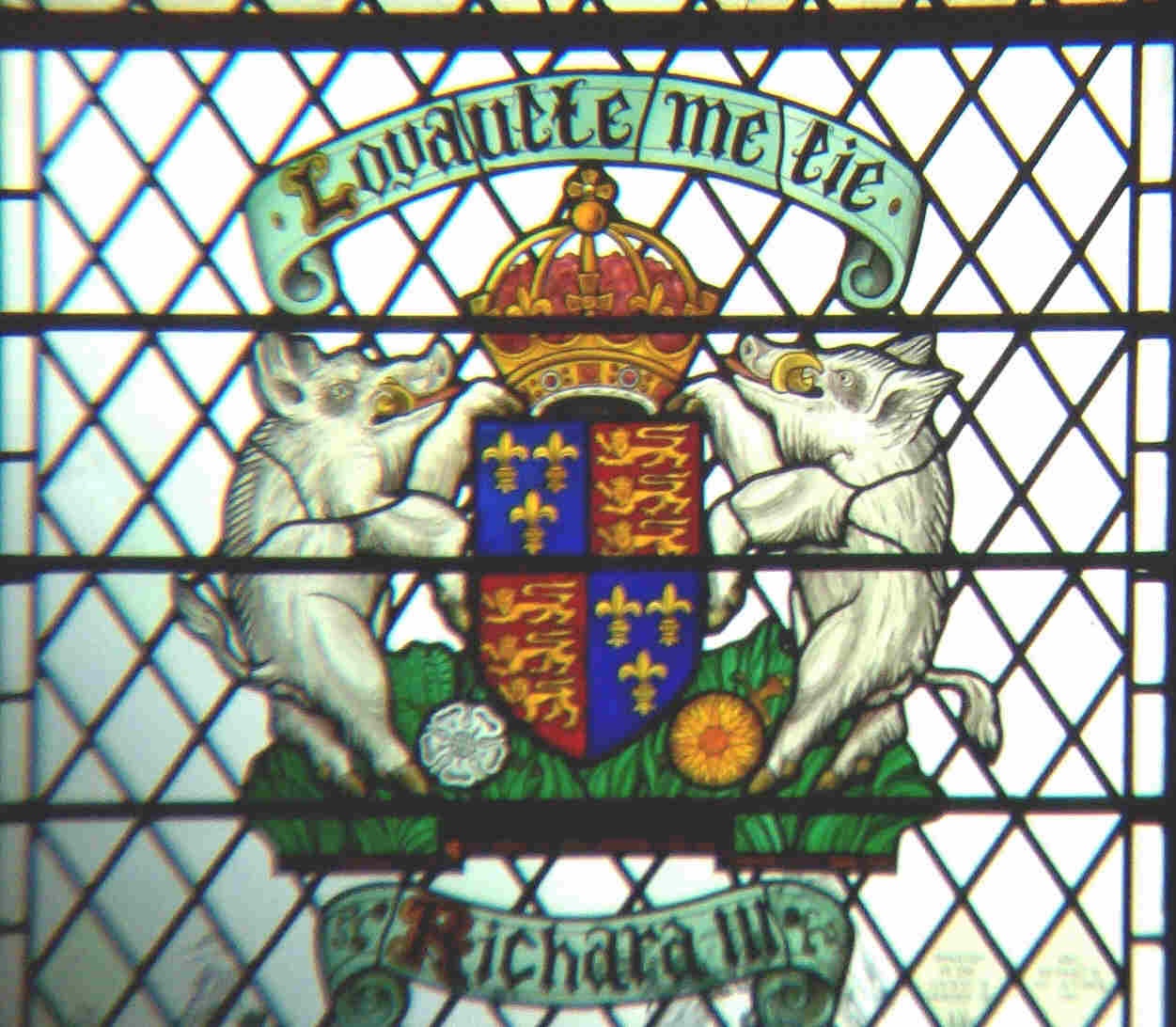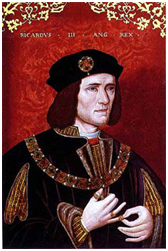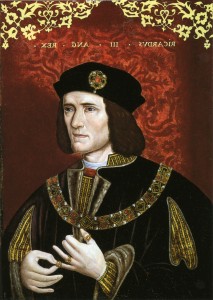KRA Week – Day 8
♕ ♛ ♕
The KRA-Week is almost over. Where has this busy week all gone?
Before we begin with day 8 news and present an interesting new blogger, Zan, our blogger of the day,
here the main site of the KRA Week 2012 and the scavenger hunt.
The quiz questions remain open for all to try their luck,
but winners will only be drawn from entries made till the
3rd of September 2012!
As soon as the lot decided on the winners, we will contact the winners and announce them here on KRA on Wednesday 5th of August, 2012!
♕ Zan ♕

Richard III – Source: The History of England, David Hume (1826)
Zan has entered the Mr. Armitage-bloggosphere only a short while ago, but already has a lovely variety of posts and articles on her blog
Well, There You Go …
Musings, Meanderings and Mutterings.
So my tip is to go over there and have a look. Her way of seeing the fandom anew is very refreshing and brings so much heartfelt warmth into fandom and it is a joy to follow her way of discovery.
For KRA-Week, she has a special report about how she discovered Mr. Armitage and his interest for King Richard III:
The Newbie Files … King Richard Week 2012
At the end of the KRA-Week, to present a new beginning of fandom, is something special. What better way to conclude our celebrations for Mr. Armitage and King Richard III.
May many fans find the refreshing and encouraging effect of fandom and supporting Mr. Armitage and his ‘royal project’.
Thank you for celebrating KRA-Week with us!
♕ Further News of the Day ♕
- The Montreal Gazett explains the importance of the mitochondrial DNA, which will be of central importance if the mortal remains of King Richard III are found: Canadian family holds genetic key to Richard III puzzle (27th of August, 2012)
- The digging is on the right track! – Medieval walls found: Medieval clue found in search for bones of King Richard III in Leicester car park (ThisIsLeicestershire.co.uk, 29th of August, 2012)
- Our special guest of the KRA-Week 2012, the
Richard III Foundation, Inc. has two very special articles about King Richard III, sheding some more light on what person he really might have been.
Those articles wet our appetite for the conference and the interesting topics, the Richard III Foundation discusses there at Market Bosworth on Saturday 13th of October. (More details and conference program here.)
♛ Thank You ! ♛
Thank you to you all, for participating in the KRA-Week and the scavenger hunt, with commenting in all the KRA-Week 2012 articles and taking part and following the event week!
We all hope, you enjoyed the week and now wish you luck and lots of fun with solving the Scavenger Hunt!
Some of you are on a really good way to be our KRA Week 2012 – Champion and we already think about extending the prices, as we have such a lot of worthy candidates.
Here again all participating bloggers of the week:
- Phylly3 (Phylly’s Faves)
- Fabo Laktuko (White Rose: Sincere and Simple Thoughts)
- Fitzg (on the KingRichardArmitage website)
- Gratiana Lovelace (Something About Love)
- Maria Grazia (Fly High!)
- Servetus (Me + Richard Armitage)
- CDoart – (CDoart: Richard Armitage – History – Spooks)
- Zan (Zaniam)
♛ Scavenger Hunt ♛
All questions of the scavenger hunt are online now!
Day 1, Day 2, Day 3, Day 4, Day 5, Day 6 and the Solution Sentence.
Entries till the 3rd of September 2012 (all time zones) get a chance to win in our KRA Week 2012.
TIP for the scavenger hunt:
To make back-solving of the answers easier for you, all the solution letters arranged in the right order will result in a Solution Sentence.
The form with the right order for the letters can be reached here – or can be printed/downloaded via this pdf-file.
Richard III Foundation – KRA 2012 – Day 7
♕ ♛ ♕
Before we begin with day 7, here the main sites: KRA Week 2012 and the scavenger hunt. (All questions now available – solution transmissions till 3rd of September 2012 enter the drawing.)
♕ Richard III Foundation, Inc. ♕
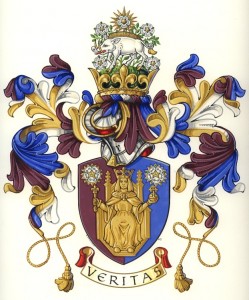
The Richard III Foundation, Inc. for quite some time supports our efforts with the petition for King Richard Armitage. (See our interview with Ms. Ricca from August 2011)
They kindly provided us with material, a special price for our Scavenger Hunt and are burning for their and our topic King Richard III.
So it is an especial joy for me to present them today as our guests here during the KingRichardArmitage Week 2012.
We have general information about the Richard III Foundation here on the website, which also includes the schedule for their next annual conference, which will take place in Market Bosworth on Saturday, October 13th, 2012.
Their price contribution for the Scavenger Hunt – Free Conference Ticket for the annual conferenc in Market Bosworth on 13th of October 2012 with lots of interesting readings and research presentations.
The Richard III Foundation has two very interesting articles for us today, because they shed some light onto an otherwise difficult to determine aspect of King Richard III, his character:
♕ Further News of the Day ♕
- Servetus (Me + Richard Armitage) – Tips for the Scavenger Hunt – Participants are already doing very well ! You are all champions !!!
- CDoart – Leporello for King Richard III?
- Phylly on her blog Phylly’s Faves presents the Richard III ballad, including the music sheet ! (Phylly is our KRA-blogger of day 2.)
- Leicester Mercury reports about the beginning of the digging over the weekend: Heavy machinery moves in as experts begin digging for Richard in Leicester car park (27.08.2012)
- ITV Central with further video and picture material about the digging in Leicester: Digging begins in search of King Richard III (dated 25.08.2012)
- Consoles me a bit that I am not the only one dying of curiosity about the digging in Leicester: Jonathan from the blog Liberal England
♛ Scavenger Hunt ♛
All questions of the scavenger hunt are online now!
Day 1, Day 2, Day 3, Day 4, Day 5, Day 6 and the Solution Sentence.
Time to answer is till the 3rd of September, 2012 (till the last time zone).
TIP for the scavenger hunt:
To make back-solving of the answers easier for you, all the solution letters arranged in the right order will result in a Solution Sentence.
The form with the right order for the letters can be reached here – or can be printed/downloaded via this pdf-file.
Francis, Viscount Lovel, by Joe Ann Ricca
Loyalty is a wonderful thing. It is that precious quality that we all desire in our relationships, but when I think of loyalty, it leads me directly to Francis Lovel.
Every monarch must rule alone, but above all else, kings need someone they can trust, who know their mind, how they will act and react, and still remain loyal. For Richard III, that man was Lovel.
Richard thought that loyalty was a man’s finest gift to others: he must have been pleased and gratified by Lovel’s devotion.
After Bosworth, Lovel stood before Tudor, and by his actions alone, showed him he would never be able to destroy the good name of King Richard III while there was breath in his body.
Lovel represents the Yorkist age in many ways. Bereft of parents at an early age, he was used as nothing more than trading material bringing great value as people used his income to better themselves. He went from a Lancastrian family to a Yorkist one, from a follower of Warwick back to the Yorkist persuasion until he finally shook off the shackles of Edward IV, Richard Neville and the Fitzhughs. He was able to emerge as his own person, and by now in close association with Richard, Duke of Gloucester, he began his own life.
Paul Murray Kendall states
“he was a man whom little is known save he was probably Richard’s oldest and dearest friend.”
Collingbourne’s refers to him as a shadowy figure and in his rhyme, he comments:
The Catte, the Ratte, and Lovel Our Dog
Ruleth all England under a Hogge.
Colyngbourne probably thought that he was very clever, making fun of people’s names and symbols, but what can it really mean? Well, only that Francis Lovel was a close advisor to the king, and that he had a fierce-looking hound on his heraldic shield. I, too, like dogs, and if I had a Garter plate I might show my Maltese on it. But if this was our only knowledge of Lovel, he is falsely described, for there was much more to the man than a shaggy coat of arms.
During my research on him, the one factor that stood out for me was he simply got on well with Richard III. He found his niche in life at the same time that Richard III was taking a dominant role in the north. Once they bonded on the fields in Scotland, they seemed to fit – two people who were separate but complete when they came together. They just enjoyed each others’ company without a lot of thought about other rewards.
Lovel was poorly used in his young life, perhaps no worse than other rich minors, but he must have chaffed while under the control of wards and in-laws, unable to live his own life. Edward IV gave him to Richard Neville as a peace offering, and Neville gave him a Fitzhugh wife in his never-ending search for retainers. Once the Plantagenets and Nevilles parted company, Edward gave the young man to his sister Elizabeth, or at least to her husband. All of this was presumably in Lovel’s interest, to teach him about life, or was it an excuse to use his inheritance to fund his guardians’ whims? Later, under the influence of Richard III, Edward IV made him a Viscount restoring much of property, though it was Edward IV who used Lovel and his wealth without shame.
There are parallels that both men shared. Francis Lovel was born, as was Richard, toward the south of England; Lovel, born in 1456, was four years younger than Richard. Both men lost their fathers at about the same age, but whereas Lovel’s mother remarried, to Sir William Stanley, Richard’ mother began a long widowhood. Lovel’s mother died very soon after her second marriage, and Lovel became the pawn of king and peers. The boys lived in what I think of as idyllic villages at Fotheringhay and Minster Lovel. That soon ended for both and they spent most of their young lives in strange territory, moving from place to place, always attempting to adjust and to be accepted by those native born. Richard was unusually well-accepted in the north, especially after he married Anne Neville. Lovel also married in the north, to Anne FitzHugh, but the FitzHughs could not command the respect that that the Neville name brought to the area of Richmondshire.
Richard and Francis were also familiar with the Neville life: Richard trained at Middleham with other Neville adherents: Francis became a ward of Nevilles. Scofield and Kendall cite £1,000 was given for Richard’s care, but Warwick didn’t receive Lovel’s wardship until November of 1467, and by 1468, Richard left Middleham. Equally novels in particular dramatize they became childhood friends while under the tutelage of the Kingmaker but given they were at Middleham together for months, how much of a friendship was formed is open to conjecture.
Each must have felt that they were political outsiders for most of their years as the pendulum swung from York to Lancaster; they were in opposite camps most of the time, but there’s no record of any face to face confrontation. At some time after the split between Edward IV and the kingmaker Neville, the FitzHughs made their peace with the king. Lovel always seemed to get along well with the FitzHughs, even until the end, so lasting friendships were important to him.
In July of 1471, Lovel moved on to live in Suffolk with the duke. He most likely met Elizabeth’s son John, destined to be the earl of Lincoln who would later unite with him in revolt. Lincoln was eight years younger than Lovel. There could have been little measuring of each other’s worth at that time. The duke and duchess were almost apolitical compared to Margaret, Edward or Richard, but in living in the same household the youths may have absorbed some common beliefs. In any case, they later worked together in harmony.
Under the terms of his wardship to de la pole, he was deprived of the lands from his grandmother, Alice Deincourt. When she died in 1474, Lovel added the Deincourt and Gray estates to his prime holdings in Oxfordshire, Northamptonshire and Shropshire. While he was now considered one of the wealthiest barons below the rank of earl, he had little to no control over his property. He should have received £4,000 from the Deincourt and Gray estates, but Edward IV made use of the money by paying a debt he owed to a London merchant. Edward freely dispersed revenues from Lovel’s estates. Over the next four years, his position didn’t change. By January/February of 1477, Lovel received his jaority, but it wasn’t until November that it was declared officially over. He returned to Minster Lovel with Anne, set up his household and Minster Lovel and petitioned Edward IV for the rest of his property. He spent the next few years legally fighting for the return of what was rightfully his. Despite his wardship under such prominent men as Warwick, Suffolk and the King, he had been badly used.
Military service for the Scottish wars that Edward planned was mandatory, especially because it was to be a large operation, land and sea. At 25 years of age, Lovel would be required to fight and rode with Richard, then full commander, in the campaign. If they had not met earlier they would get to know each other now under battle conditions. The Scottish nobles chose to abandon their king. There were no pitched battles except at the storming of the castle at Berwick and some bother at Dumfries. Richard knighted Lovel in 1482 along with his brother-in-law Richard Fitzhugh at Dumfires. Lovel in turn knighted William Hilton and Richard Radcliffe, soon to be one of his co-counselors. This is the first indication that Lovel was considered to be in the close and trusted circle of Richard III. Lovel’s attachment to Richard is indicated in his letter to his neighbor, William Stonor stating he would return south as soon as he could, asked if he could see to his game at Rotherfield, and added that his
“duty and worship lies in the north”.
The year of 1482 saw Francis in the company of Richard and the Earl of Northumberland, and in November accompanied them to Parliament. Lovel was no one’s man but his own and was now legally announced as “Lord Lovel Holand, Deincourt, Burnell and Gray” and witnessed the praise Edward IV bestowed on Richard for the success of the Scottish campaign. The following year, Francis was elevated to Viscount. Richard was influential in Lovel’s elevation which opened the path for him to receive future grants and appointments.
We do not know where Lovel was at the untimely death of Edward IV, but he was not present at his funeral. He may have been in Minster Lovell joining Richard when he entered London. During Richard’s protectorate, Edward V elevated him to Chief Butler of England, and in August, he was reappointed to the same position by Richard III. Lovel was appointed Chamberlain almost as soon as Richard was made king. As such, he was featured at the coronation, but even before that, behind the scenes as usual, Richard allowed him to find a ring for Queen Anne to be used during the ceremony. He found a pearl and sapphire one that pleased Richard; apparently their taste in jewelry was similar and shared by Anne.
After the coronation, Richard set out on his royal progress referring to it as “our great journey”. Among the locations that they stopped at was the tranquil village of Minster Lovell. The manor, not as we view it today, must have been magnificent. Their journey took them to York where Richard’s son was invested as Prince of Wales, and on their journey back to the capital, they stopped in Lincoln on October 11. During his stay there, Richard heard of Buckingham’s betrayal. Francis had lived in so many places, but always under someone else’s rule, therefore he had no power base to command or draw upon, and when he ordered an Oxfordshire lord to meet him for the march south; the lord, Stoner, not only didn’t meet him but joined the enemy.
What kind of man was Lovel?
It seems he had some training though nothing extensive as a knight or soldier. He didn’t fight at Barnet or Tewkesbury, and his first type of military action was during the Scottish campaign. He gave to colleges and churches, he and his wife Anna were both members of the Corpus Christi Guild. He owned an inn in the parish of St. Faith, London simply called “Lovel”. Simply titled, perhaps that tells us something about Lovel.
Richard tried to establish Francis in Oxfordshire with a power base, but he never succumbed to the lure of power. He was more content at court. Lovel didn’t have control of his property long enough for us to decide if he would act as nouveau riche, but he didn’t seem to yearn for power or display, or titles or battles to fight; he simply settled down to become a good servant and better companion. Richard was so confident of Lovel’s honest nature that he even recommended him as an estate manager to his mother to replace none other than poet Colyngbourne who had given Lovel fame. That letter still exists, testimony of one man’s belief in another.
Everything went wrong at Bosworth for all Yorkists, and many lost their lives to the treachery that dominated the field. For Lovel it was a personal defeat of great magnitude. Stationed on the southern coast, his mission was to prevent Tudor from landing there or, if possible, to catch Tudor at sea and destroy him. Tudor had no intention of landing on the southern coast and left France, turning west, and slipped beyond Lovel’s reach. It would have been extraordinary good luck if he had intercepted him at sea, since that seldom happened. Tudor had decided to land in Wales as near as possible to his birthplace at Pembroke where the Tudor name could draw a crowd. There he counted on his Welsh friends, those hardy and determined descendents of the rebel Glendower, to once again have a go at the English crown. There is irony, perhaps, in that the Mortimers had once joined that Welsh rebellion, but now their descendents, sitting on the English throne, were the targets.
As the Welsh revolt spread, Lovel was locked in at Southampton, defending the most vulnerable point of attack until it was too late to rush to the defense of his king as Tudor began his long northern sweep into London and victory. King and pretender met on a field near Sutton Cheney. Traitors ruled the battlefield: Tudor won. Tudor had the pleasure of declaring that all of Colyngbourne’s quartet were dead, but he was premature, for Lovel lived. It is almost certain that he had arrived, perhaps with reinforcements, after that short and bloody battle, only to find that all that he held dear lay in ruins at his feet and that he was a hunted man. In grief, he heard that his step father, William Stanley, had been the instrument of destruction for Richard. He was outraged and probably guilt ridden, but that chapter was closed; the reality was that now he had to survive under a king that he would never recognize.
The first source to disclose Lovel’s whereabouts after Bosworth was Tudor himself. He also listed the earl of Lincoln as dead so who can believe the word of a Tudor. In his proclamation, he lists Lovel as one of the dead; a combination of Tudor propaganda and to discourage any surviving Yorkists to start a rebellion. Perhaps he wasn’t surprised heard of Catesby’s fate, hauled to Leicester and executed. He probably knew, from the proclamation, that Radcliffe was dead on the field along with Brackenbury and Howard. He knew that young Howard, wounded, was thrown into jail along with Northumberland. In the camps of the defeated about him, all of the talk would have been of traitors, of the Welsh invasion, of the triumph of a man who had no claim to the throne. With others, he drifted west and south until he reached Colchester and sanctuary at St. John’s, there to nurse his hatred and to plan his revenge.
Lovel was never in a mood to give up, to seek a pardon as could be expected, then to resume life as a Viscount under the new king. He would never serve under another king, and he no doubt knew, he would nevr survive. Many others, his friends, took oaths or posted bonds, tongue in cheek, to support Tudor. But not Lovel.
Without hesitation he began to organize a revolt, but, of course, the odds were against him, and he was new to the game. The Stafford brothers, previously key to quelling Buckingham, were with him in sanctuary, and most willing to do battle. But others were dazed and defeated by Tudor, cautious, waiting to see what would happen, and Lovel could not be sure of them. Many were ready to pounce given an opportunity, but unwilling to commit suicide for a lost cause. Margaret of York, the most powerful Yorkist left standing, was an obvious one to help, but she was only a Dowager Duchess, unable to commit on her own, dependent upon Mary’s son and Maximilian. Those two, like any rulers, officially began to negotiate with Tudor, trying to find advantage or to ward off trouble. Maximilian was busy trying to become the king of Germany and Holy Roman Emperor, and he was vulnerable in Flanders, and the great and evil shadow of France always blocked his horizon. Since Tudor was a product of French interference in English affairs, it seemed certain that Burgundy would have to side against him, hoping to restore the friendly Yorkists to power one more time.. But Maximilian could not act in 1486, only hint. Lovel could wait in sanctuary or he could go out and sound out his countrymen, organizing a rebel army, dormant but sworn.
He and the Staffords left sanctuary in 1486 and went north and west to try to raise support. The Staffords overreached and actually took control of an area, forcing Tudor into a pitched battle which they lost, then rushing back into sanctuary at Cullum. But Tudor was having none of this; he yanked them out of sanctuary and executed one of the brothers, Humphrey. He went further; many times before, people had been taken from sanctuary, but always as a sort of last resort, with apologies all around, not as royal policy. Tudor changed the law; sanctuary was not available to traitors, and those who left and returned to sanctuary were traitors by definition. Meanwhile Lovel, working more to the north, was spawning rumors of revolt as he was gathering pledges and seeking allies. As Tudor went north on his first progress he worried, even though Lovel did not seem to be seeking a confrontation. Tudor gathered an army about him and resolutely went on to York, driving Lovel before him. There were those who might have fought at this moment, but they were scattered and hesitant, while Tudor was at his military best. Lovel was a much-sought-after fugitive now, with sanctuary a death trap that Tudor would snap shut without mercy. The only possible way to continue resistance was to go abroad. He left England with promises of support from many of the lords of the north, but clearly not enough support for an internal revolt. He had to go to Maximilian to ask for military might if he wished to upset Tudor.
It was accepted military philosophy that 2000 stout-hearted rebels could come to England and change the crown from one head to another. Richard II had been deposed with less, Edward IV, Neville and Tudor had done it with so few. Iron will, luck, professional soldiers – that was all it took. Lovel now had these. Certainly the iron will to avenge Bosworth, As for luck, hadn’t he risen from Tudor’s death proclamation and escaped the hunt for him in England? And weren’t Maximilian and Margaret of York willing to give him money, ships and soldiers? This was his moment in history.
It is quite obvious that if Margaret of York had not married into the ducal family of Burgundy that the Yorkist regime might have ended many years before, and that the triumph of Richard III might never have occurred. Now, post-Bosworth, Margaret and Burgundy were to assume a major role in the attempt to again restore the Mortimer line to the throne. If Lovel had any moment of true greatness it was after he left the northwest with his 1486 rebellion in tatters. Lovel, had convinced Gerald FitzGerald, the earl of Kildare and the real ruler of Ireland, to join the conspiracy. Ireland was considered ’Yorkist’ in some respects even as it was anti-English in all respects, and perfidious George, the Duke of York’s son, had been popular there, even being born on the island. The idea of his son, Edward, earl of Warwick, becoming king appealed to FitzGerald just as it did to Margaret of York. An agreement was reached. The real Edward of Warwick languished in the Tower, entirely at Tudor’s disposal, and there was real fear that his life would be in jeopardy. Lovel had a priest from Oxford bring a suitable young proxy to Ireland so that they could pretend that the real Edward was free, that he had escaped to Jersey, where the rebel Richard Harliston held sway, and that Edward was therefore under the protection of Margaret of York.
If this seems improbable, consider that there really was a plot to liberate Edward of Warwick from the Tower, and that John Sant, the man who tried to help the Staffords to sanctuary, and Edward Franke and Henry Davy, retainers of Lovels, were accused of being involved. It came to nothing. As far as contacting a priest from Oxford, it must be remembered that Lovel lived close by, had visited there with Richard III, and had once put some property in trust for Anne if she would find two priests from Oxford to pray for his soul for thirty years after his death. As far as finding acceptable young men to go to Ireland, Oxford was probably a good hunting ground. It is nonsense to think that they tutured a proxy that everyone knew was a proxy in all of the life of the earl; all that he really had to do was avoid dropping the crown or insulting the earl of Kildare. The ceremony could not have been taken seriously as the crowning and anointing of an unknown; think how hard it might be to get rid of him later if he took a liking to Dublin and decided to move the capital there.
Lovel either went on then to Burgundy or returned there to get agreement on money, ships, and soldiers. The plot was accepted immediately, and 1487 was a better year for Maximilian to become involved in a sub-rosa war with England. He was still negotiating with the new king, stalling and hoping, and he was deeply involved in becoming the king of Germany, but there was a lull that he could use. It seems certain that by January of 1487 at the latest, planning turned to action. The money was supplied, the military assembled, and the proxy arrived in Ireland. In February the priest who had brought him to Ireland was induced by Tudor to confess his role, and the real Warwick was taken from the Tower and paraded in London by an irate Tudor. For whatever reason he also arrested Thomas, the Dowager Queen’s son, and deprived Elizabeth Woodville of her property and put her in a nunnery. The fact that Henry had married her daughter, but not crowned her as promised, may have made Henry suspect that they would join rebels, although by now the best bet for the Woodvilles was Tudor.
To add to Henry VII’s woes, his new ‘friend’, the earl of Lincoln, slipped out of England along with Thomas Broughton and joined the conspiracy in Burgundy. Lincoln’s role was probably twofold; to bring in other supporters within England and to serve as Protector during the minority of Edward. And, if Tudor should suddenly execute the real Edward of Warwick, Lincoln would provide a back-up pretender. Lovel, as always, seemed willing to share power and didn’t consider at any time that the revolt was in his favor, despite being the major conspirator. Had he been successful he would have remained in the background, perhaps on council, but more likely returning to a job such as chamberlain.
Lovel’s immediate success in bringing together Burgundy, Ireland and the English rebels was really quite a coup. He could not have done it without Margaret’s help, but the actual fabric of the scheme may well have resided only in Lovel’s mind. He had risked his life after 1486 when Tudor would almost certainly have snuffed him out as he had Stafford, and it is never easy to convince a FitzGerald or a Maximilian to throw the dice when the out come could be disaster, but Lovel did it. The outcome did turn out to be a disaster for the rebels, of course, but for those who abhor the injustice done to Richard III, Lovell can only be applauded. Naturally, not all of the participants were Yorkists pure of heart as Lovel was; FitzGerald wanted to rule Ireland unfettered, Maximilian wanted to thwart France in any way he could, Margaret, we find out later, was perhaps overly concerned about her perks from the English crown, although we should never doubt her intense interest in destroying Tudor.
All of the rebels met in Ireland for the grand gamble of war. The Burgundian army was professional, professionally led, and FitzGerald was willing to supply double their number in Irish troops. This was a welcome addition, although the Irish were not professional soldiers and were poorly equipped. As an added token of FitzGerald support, the earl’s brother, Thomas, would lead those troops. If the Welsh could seat an English king, so could the Irish! Not all of Ireland agreed, but with most everyone assembled the proxy coronation took place smoothly, never mind about any thoughts that Tudor had thoroughly trounced the Yorkists once. Spirits were up; the rebels had an army of 6000, a legitimate king in the real Edward VI, and many supporters in England who would join at the right moment. The rebels boarded ships and sailed to Foulney Island in Furness, then rapidly marched to Yorkshire, where their greatest strength lay. They route took them into Wensleydale passing through Hawes, Castle Bolton and Middleham, Jervaulx Abbey before reaching Masham on June 8th. Recruits did join, but not in the numbers expected. Lincoln’s estates lay in East Anglia and the Thames Valley and Lovel, now attainted, was landless. They pinned their hope on the old loyalties of the men in the area. The city of York would not open their gates when requested to do so, nor would they yield when Lords Scrope appeared and demanded entrance. The rebels could easily beat of a clumsy attack by Lord Clifford, but in the background those old warhorses of Tudor, his uncle Jasper and John, the earl of Oxford, were gathering a large force. And the Stanleys, under the leadership of the new Lord Stanley, George, even sent an armed audience to observe the proceedings. Tudor and the Yorkists clashed at Stoke; with huge losses on both sides. Tudor won again. There were rumors of Tudor’s death in battle, although he had not personally been near the fighting, and there were riots in London because of this, but the real losers were Yorkists. Lincoln, Martin Schwartz, the military leader, and Thomas FitzGerald, the Irish soldier, all died.
Some of Lovel’s associates such as Maximilian, FitzGerald, Margaret of York and many others continued their lives after Stoke with not much changed. The real Edward, earl of Warwick, stayed put in prison for many more years until Tudor finally executed him when he had reached maturity. Some, like the Scropes, were fined and restricted, and eventually Tudor brought FitzGerald, the earl of Kildare, to heel, although he remained a power in Ireland. Those who suffered the worst were undoubtedly the poor Irish troops, who were slaughtered almost to a man; unprotected skin is no match for a longbow and many of the Irish were hit repeatedly. In terms of casualties, Stoke was far, far worse than Bosworth.
Stoke had one curious similarity to Bosworth in that neither Tudor nor Lord Strange did any fighting. At Bosworth, Northumberland is always criticized for not attacking someone from his rear guard position, but, since Tudor and the Stanleys were the winners, we hear little criticism of their lack of support. While they watched, Oxford’s troops suffered horrendous losses, almost half being cut down. Tudor himself, directly behind Oxford’s men, apparently did not reinforce him with the main battle, but simply watched as Oxford bled. It’s hard to criticize the winner.
Now we come to the question that is always asked: but what happened to Lovel? The theories are many. The Great Chronicle of London and the York City archives claim Lovel died at Bosworth. We know that is not true. Some claim he died in battle, his body overlooked and is among the others in the mass grave at St. Oswald’s church in East Stoke. Others claim he drowned while swimming his horse across the River Trent. The summer of 1487 was unusually hot and dry with the River Trent being 50 yards wide with reeds, but if the water was shallow, and the hooves of his horse became entangled in the reeds, could he have drowned? We can disclaim this theory too.
He most definitely escaped Stoke. The unnamed herald of Tudor along with the MS 2M6 from the College of Arms indicate “The Viscount Lord Lovel was put to flight” while the latter states “with money many other gentilemen too. Both documents name the leading rebels were either captured or slain in battle, but the inference is Lovel made good his escape. So where did he go? His manor at Stoke Bardolf was nearby and it could have offered him a brief respite before he continued on.
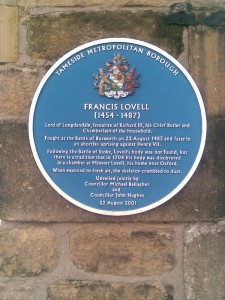
Francis Lovell Plaque – Source: Wikipedia.org
There is the popular tradition that Lovel escaped to Minster Lovel. In 1728, William Cowper, clerk of the Parliament to Francis Peck, an antiquarian records that in 1708, they were laying a new chimney in Minster Lovel and discovered a room underground. A skeleton of a man with a cup, book, prayer, pen etc. was discovered. The problem with this theory is that Minster Lovel had no basement. Lovel would have known his property would be forfeit to Tudor so why risk going there? We know his connections in Oxfordshire were not strong so who would he have to trust?
What was the role of the Fitzhugh’s? During the Neville revolt FitzHugh received a safe passage into Scotland for his entire family, including Francis Lovel. This was issued by James III, and some suspect that there were similar negotiations in 1485. In February of 1488, Alice Fitzhugh wrote to Sir John Paston. Her letter indicates that Anne Lovel knew her husband survived the battle, but she had no contact with him for a considerable period. She had sent Edward Franke, his right hand man, north in search of him, but he returned with no news. Did Franke go north to help Lovel? On June 19 of 1488 James IV actually issued a safe conduct for several rebels, among them Frank, Hartilton, Lovel and Broughton. Alice Fitzhugh wrote to Sir John Paston in FebruaryThere is reasonable evidence that Broughton took advantage of this and lived in Scotland until May, 1492, when he returned to Cumbria. By late 1492 there were reports that Lovel had died in Scotland, and this does coincide with Broughton’s return. Broughton returned to live among his tenants in Witherstack in Westmoreland.
In the 1490’s when Perkin Warbeck circled around Scotland and England like a persistent horse fly, Lovel did not emerge. Even if Lovel did not believe in the prince, their mutual association with Margaret would almost assure his appearance. This seems positive proof that Lovel was either dead or so badly injured and discouraged that any career as a rebel was impossible. At no time did Perkin Warbeck acknowledge him.
In 1510 there was a property dispute that hinged on whether Lovel or Lord Beaumont died first. Beaumont died in 1508. The jury decided that Lovel outlived Beaumont, that the property was therefore his and was forfeit. This seems like excellent testimony until it is realized that the man who benefited from all this was Tudor. It seems improbable that Lovel was alive then, now age 54.
What are we to make of Lovel’s life? He was not a fighting man; there is no record of his knightly training, and none of battle experience. He seems more to have been an administrative type, an executive, a friend and advisor. After the death of Richard III, he emerged as the avenging rebel. He was outraged enough to organize a revolt. He seemed to do this for no other reason than to right a wrong. He easily could have made his peace, like his peers, with the new king living a safer, richer life. But, instead, he did his best to organize a counter invasion that would drive Tudor out of England, back into exile and into the obscurity that he deserved.
He was transformed from a wealthy peer to a fugitive dependent on the good-will and favors of others. Francis demonstrated that precious quality of loyalty to a man and a dream of better government. We know of no instance of simple greed or avarice, of false loyalty, of uncontrolled egotism. He made the history books as a failure, surrounded by failure, but we also see him as a success in one value that we admire, loyalty. Lovel simply honored Richard III in the most dramatic and selfless way, and if we reflect on that, how fortunate Richard III was to have such a friend.
Transcript of a presentation by Joe Ann Ricca (Richard III Foundation, Inc.)
Badge of the White Boar – by Joe Ann Ricca
In the spring of 1475 Richard Plantagenet, Duke of Gloucester, sent his call out to raise an army by indentures, or the contracts to supply bodies of soldiers at so much per man, to support King Edward IV’s attempt to reconquer some of the provinces from which the English had been evicted a quarter of a century before. Paul Murray Kendall tells us that Richard had one of the largest contracts for men of arms, agreeing to bring into the field 120 men-at-arms, with 1000 archers.(1) In order to maintain as much order as possible, as well as to count heads before the general melée began, it would be necessary for each man in Richard’s contingent to wear a badge displaying his emblem of the White Boar (blanc sanglier).
Generally the idea of using decorated shields, breastplates and standards went back many centuries to the Greeks and Romans, but these were mostly for decoration, and not used as personal identification as was the heraldry of the feudal knight.(2) What we commonly look to as a means of identification for the armored knights was not used in feudal Europe and England until early in the twelfth century.
However, when the Roman Empire was broken up, a corresponding sea change (I don’t understand the phrase “sea change”) in the distribution of property occurred, resulting in two major categories of property ownership. One was termed allodium, or the inherited possession of land belonging entirely to its owner; and the second was the feudum, or land that was leased by the king or high-ranking lord to a vassal as a feudatory tenant. For the privilege of using the land to produce his means of subsistence, the feudatory tenant owed certain duties to his lord, one of the main ones being the support in person of any military pursuits which the lord decided to undertake.(3)
Up until the first Crusade, most of these operations were undertaken by relatively small groups of armed men and it was not imperative to mark what was readily apparent, that is just who was a friend or foe. But when forced to make common cause with other like-minded strangers, the need for a specific badge came into its own as the need to keep close to your own side became a matter of immediate survival.(4) So out of necessity, a system of military identification was born, first showing recognizable symbols of a particular person and then coats of arms or official symbols of a family conglomeration.
The word ‘heraldry’ is derived from the word ‘herald’. The herald of the Middle Ages was a messenger between rulers, a sort of ambassador or emissary at times, walking the tightrope between enemy camps and after the battle counting up the dead and identifying prisoners. However, the spread of arms occurred so rapidly and the knowledge of which symbols designated who was whom in the warlike medieval society became so important that heralds evolved into people of some consequence rather quickly as they also became responsible for the organizing of state ceremonies and tournaments. Thus, the herald became an expert in ‘armory’, a finely honed skill of recognition and eventually registers were worked out in order to keep control of all the arms in their official sphere.
In 1475, Richard of Gloucester’s chief officers of arms, who supervised the making of banners and “cognizances”, were the Gloucester Herald and Blanc Sanglier Pursuivant (5) (the lower ranking heralds, or pursuivants’ names were taken from the iconography of the lord’s badge (6) ). What we have commonly come to know as a coat of arms in the language of heraldry refers only to the devices borne on the shield. The full display of all the devices to which the armiger is entitled by inheritance is an achievement of arms or simply an achievement. Part of the achievement may be a personal insignia chosen for any number of reasons; however a verbal description was needed so an articulation of any part of the achievement or its entire composition including the badge came to be known as a blazon (7).
Badges had widespread use during the War of the Roses, promoting the well known white rose of York, and the red rose of Lancaster, both descending mainly from the gold rose of Edward I. Ultimately, Henry VII reunited both badges into the Tudor rose, which has since been a royal badge and the emblem of England. However, in most cases, there was usually a reason for adopting a particular personal badge, be it sentimental, political, commemorative, or of a family association and it was often more generally recognized than the arms. Some of the better known badges have been; the pre-heraldic red dragon of Cadwallader, which was a British tribal emblem and succeeds as a national symbol for Wales; or the Prince of Wales’ feathers, which probably came from France.
Richard’s special cognizant was a Boar rampant argent, armed and bristled (8). In the catalogue of heraldic terms, the Boar may be termed sanglier, or a wild boar, and occasionally the boar’s head will be blazoned ‘erect’ and is shown with the mouth upwards. Rampant designates the attitude or posture of the animal as erect, in profile, one hind paw on the ground, the other three raised tail erect. Argent refers to one of the tinctures or colors of heraldry, namely the representation for a metal, as silver usually represented by white. When a designated beast is said to be armed and bristled, the blazon reference is to horns or tusks for the former term, and the latter term denoting that the bristles on the boar’s head may be a different color, that is crined or bristled of the tincture. (9)
All sorts of household and military equipment carried the badge, as well as clothes. Banners displaying part of the achievement might be in the shape of a pennon, square, or a long standard as exampled in Figure 1.
Sides of an achievement of arms are designated as if the bearer were located behind the shield, so the right hand side is called the sinister, and the left hand side the dexter. Here we see the Boar passant, or walking with three paws on the ground and the dexter fore paw raised, looking forward, armed, tail curled.
From the window in the York Minster, the rampant White Boars, heads erect, stand on the compartment or the area of footing, representing solid ground and acting as supporters for the royal shield. The well-known motto of Richard III, Loyaulte Me Lie, (Loyalty Binds Me) appears in a banner in the top of the window, while a banner with a name plate appears at the bottom. Further, there is identification by the heraldic symbol of the royal crown, which in this case shows a circlet of four crosses alternating with four fleurs-de-lis and a red cap after the crown of Henry VI (10).
Although there is no certain knowledge of the origin or meaning of many of the devices that existed, even among the heralds of the fifteenth and early part of the sixteenth centuries, we can outline with some confidence the various factors that might have caused some of the components to be preferred by the armiger.(11) At first blush, the choice of the White Boar for a personal symbol is not as obvious as the much- used symbol of the Lion of other armory. But if we proceed in selected stages, we can garner enough knowledge to approach an understanding of the implications of the badge of the Blanc Sanglier.
At the outset, there is some opinion that by choosing the badge of the white boar, Richard was identifying himself as an individual, separable from his birth, his rank, his family, and his in-laws, all of whom had their own particular emblems that he was entitled to display.(12)
Representing the boar as white has several implications. It is known that the Trojans of royal blood adopted distinctive colors so that their deeds and prowess in combat were duly noted by the reporters of their battles. White, or the argent in heraldic terms, is considered to be the noblest of colors, as it is the foundation of all other colors and it is the only color that has a direct counterpart in the color black. Also, for good notice, no other color can be seen as far away and as clearly as white.(13)
It has been noted that to bear a boar in arms signifies a valiant, wily and envious warrior who prefers to die than to save his life by flight. Such a beast is so fierce that by all accounts when pursued, it will sacrifice itself rather than surrender in the hunt; an illusion no doubt to Richard’s prowess as a soldier.(14) Conversely, overcoming the boar is considered to be the feat of a remarkable hunter as in the account of the legendary worthy Guy of Warwick.
Identifying with a greater personage in medieval times had much the psychological import that celebrity worship has today. We celebrate a certain aspiration of accomplishment; thinking, or perhaps hoping, that one’s display of loyalty is, or might be construed by association, as the calculation of a more knowing mind or purer heart. So there seems some possibility that the testimony of an early German translation of the famous romance of Tristan and Isolt, by Gottfried of Strasbourg, who cites Tristan’s arms as featuring a boar may have found its way into Richard’s thinking.(15) Any such earnest belief on Richard’s part was extended, and reciprocated as his entourage of personal well-wishers, supporters, and adherents grew exponentially with his rise to the throne. The evidence lies in the records that show for his coronation in 1483, Richard ordered 13,000 badges of the white boar.(16) One of these survives in the British Library.
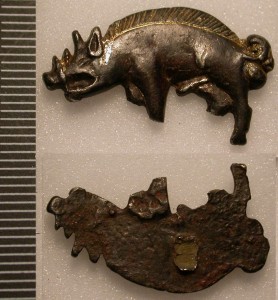
Boar Badge of Richard III from Bosworth Field – Source: Wikipedia.org
All that said it makes the oft-referred-to account of the abuse of Richard’s corpse that much more obscene when we are told that after Bosworth, his body was ‘despoiled to the skin’, was trussed behind his pursuivant Blanch Sanglier ‘as an hog or another vile beast and so all to besprung with mire and filth, was brought to a church in Leicester for all men to wonder upon and there lastly irreverently buried’.(17)
NOTES
- Kendall, P. M., Richard III, New York,1955, p.133.
- Buehr, W., Heraldry, The Story of Armorial Bearings, New York, 1964, p.15.
- Neubecker, O., Heraldry, Sources, Symbols and Meaning, New York, 1976, p.6.
- Ibid.
- Kendall, p.133.
- Neubecker, p.24.
- Fearn, J., Discovering Heraldry, Buckinghamshire, 2000, p.12.
- Pinches, J.H., and R.V., The Royal Heraldry of England, Rutland, VT.1974, p.122.
- Fearn, Heraldry, p. 25.
- Ibid., p. 47.
- Planché, J.R., The Pursuivant of Arms, London, 1874, p.274.
- Hicks, Michael, “Richard Duke of Gloucester:The Formative Years”, in A Medieval Kingship, ed., John Gillingham, New York, p.36.
- Jones, Evan John, Medieval Heraldry, Cardiff, 1943, pp. 1-7.
- Ibid., p.29.
- Brault, Gerald J., Early Blazon, Woodbridge, Suffolk, 1997, p. 20.
- Neubecker, p.208.
- Wagner, Sir Anthony, Heralds of England, London, 1967, p.134.
BIBLIOGRAPHY
- Brault, Gerald J., Early Blazon, Woodbridge, Suffolk, 1997.
- Buehr, W., Heraldry, The Story of Armorial Bearings, New York, 1964.
- Fearn, J., Discovering Heraldry, Buckinghamshire, 2000.
- Hicks, Michael, “Richard Duke of Gloucester:The Formative Years”, in A Medieval Kingship, ed., John Gillingham, New York, p.36.
- Jones, Evan John, Medieval Heraldry, Cardiff, 1943.
- Kendall, P. M., Richard III, New York, 1955.
- Neubecker, O., Heraldry, Sources, Symbols and Meaning, New York, 1976.
- Pinches, J.H., and R.V., The Royal Heraldry of England, Rutland, VT. 1974.
- Planché, J.R., The Pursuivant of Arms, London, 1874.
- Wagner, Sir Anthony, Heralds of England, London, 1967.
Special thanks to Mr. W. G. Hunt, Windsor Herald of Arms, at the College of Arms, for taking the time to get me started.
KRA Week – Day 6
♕ ♛ ♕
Before we begin with day 6, here it the main site of the KRA Week 2012 and the scavenger hunt now with all daily questions and the form for the solution sentence opened.
♕ Fitzg ♕
Today’s blogger Fitzg is a well known blogger, though she does not have her own blog.
With her witty guest blogs at Judiang’s blog (www.jagrant.com) she and her well loved posts have an among fans popular online home.
Though today, we were able to steal her away from Judiang with her contribution for the KingRichardArmitage Week:
Leicestershire Revisited
Fitzg visits Leicestershire and brings in its influence on Mr. Armitage and his historic interest.
Her today’s post on Judiang’s blog goes on a journey to search for a saint for Richard Armitage. (As if he were not a saint himself. Good, I admit, perhaps half a saint ;o)
Fitzg’s Journeys: Seeking A Saint
♕ Further News of the Day ♕
- Servetus (Me + Richard Armitage) – has some more quiz tips! – But so far, contributors are really doing well. You all are my quiz champions already !
- CDoart – starts to discover a website about a secret code in a Holbein family portrait
- The BBC has a video about the Leicester digging with information about the location and a short interview with Philippa Langley online on their website about the archaeological project in Leicester: Richard III’s remains: Leicester car park dug up
- Daily Mail Online also has a report about the digging for the lost grave of King Richard III, with further information: Is this the lost grave of King Richard III?
♛ Scavenger Hunt ♛
All questions of the scavenger hunt are online now!
Day 1, Day 2, Day 3, Day 4, Day 5, Day 6 and the Solution Sentence.
Time to answer is till the 3rd of September, 2012 (till the last time zone).
- The Richard III Foundation, Inc. sponsors a free conference ticket!
Free entry to their King Richard III Conference on 13th of October 2012. – More details and program of the conference here.
TIP for the scavenger hunt:
To make back-solving of the answers easier for you, all the solution letters arranged in the right order will result in a Solution Sentence.
The form with the right order for the letters can be reached here – or can be printed/downloaded via this pdf-file.
Leicestershire Revisited
Richard Armitage Birthday Week 2012
photo: goleicestershire
The BBC series “Kibworth”, with historian Michael Wood, (broadcast on PBS) renewed a desire to return (in cyberspace) to that midlands county. Which was already stimulated by the history of Richard III and the Battle of Bosworth. Oh, and that other Richard, of our acquaintance, celebrating a birthday this month….

richardarmitagenet Candids Gallery
Kibworth, a village a few miles outside Leicester, was revealed by Michael Wood as a complete microcosm of “the story of England”, from pre-Roman settlement to the present day. During a months’-long sojourn in the village (almost of town proportion now), Mr. Wood explored the origins and progress of this supposedly unremarkable part of the county. He did so with the enthusiastic participation of the inhabitants. Kibworth represents a microcosm of the races/nationalities who have become embedded in the DNA of England. Continuing research by DNA scientists is not conclusive yet on the subject of who is a Celt and who isn’t. No doubt that debate will continue.
Leicestershire – worth a visit? Leicester itself, now with a growing Asian population. Yet another layer of the long-existing multi-culturalism of England, with waves of settlers and invaders dating from the Bronze Age. Britain has always been a melting-pot.
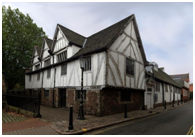
Leicester Guildhall. Wikipedia: attribution: NotFromUtrecht
Digging up History… (in spades)
Sufficient research has been done to suggest that the bones of Richard III probably did not end in the River Soar, but at some point, were removed to Greyfriars in Leicester and properly interred there. Thanks to some Tudors, Greyfriars has long since been pounded into the ground. An archaeological project, sponsored by the University of Leicester, and the City Council, among other supporters, has begun a dig. If they are correct about the evidence that there was a coffin containing the remains of the last Plantagenet king, discovery, and DNA testing will add to the historical record of England.
More than five hundred years since Richard III was brutally murdered by the party of the Lancastrian invader Henry (Tudor) VII, the question of Richard’s culpability in the apparent deaths of his pre-adolescent nephews, remains disputed. The last Plantagenet died at Bosworth, Leicestershire, August 22, 1485. August 22nd. Time for celebration of life.
Based on the portraits, who would you prefer?
Leicestershire and Richard Armitage
Although Mr. Armitage has grown (yes, grown. And grown (And grown…) to be a citizen of the world, as well as of London, the heart of England, no doubt, had been a good grounding site for an English actor. And Leicestershire is in the heart of England. Perhaps the heart of England. Perhaps Mr. Armitage will play the role of his namesake one day, in a realistic production of that tudorised king. For the numerous among our support group who are not overly fond of beards, they will be relieved to know that clean-shaven was the norm with the 15th C man….
And during this week, we wish Mr. Armitage :
MANY HAPPY RETURNS!
(He’s all grown-up, now. 😀 )
KRA 2012 – Day 5
♕ ♛ ♕
Before we begin with the Day 5 news…
Today we sent out the confirmation mails to the un-confirmed signers of the petition. Thank you for your help and support!
And here are the main sites, the KRA Week 2012 and the scavenger hunt.
♕ Fabo Laktuko ♕
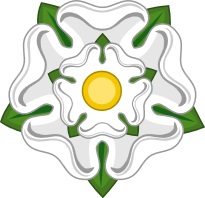
Fabo Laktuko is an experienced King Richard III blogger and her expertise in filming and film related topics and personel is an unending source of information. She brings wonderful new perspectives into the historic topic.
Today, she has a knowledgeable review about possible producers for us, who we as fans might trust and who could support Mr. Armitage in creating his dream project:
Four Directors Richard Armitage Should Consider for His Richard III Production
Fabo Laktuko also has interesting information about other film and King Richard III related topics and especially scavenger hunters will find her previous articles very helpful:
King Richard III posts
♕ Further News of the Day ♕
- Servetus (Me + Richard Armitage) – What a thumb can tell in battle and especially regarding success – Or: Richard III thumbshot
- CDoart – Germans everywhere? And that even before a functioning tourism industry.
- The BBC History Magazine published a very interesting online article by Dr. David Hipshon about the reasons for Bosworth: “Treachery: What really brought down Richard III“
- Our special guest, the
Richard III Foundation, Inc.,
who will join in with an article during the week and are sponsoring a price for the scavenger hunt, have released a press release regarding the late Channel 4 appeal for a King Richard III documentary and their upcoming King Richard III Conference on 13th of October 2012. They welcome members and guests !!! – For more information also take a look at the program of the conference here.
♛ Scavenger Hunt ♛
Questions of Day 1, Day 2, Day 3, Day 4 and Day 5 are online now.
Servetus, as our quizmaster of the KRA Week 2012, has some tips and tricks for you to solve the quiz questions: Day 5 tips
Also take a look at her further articles this week. They contain hints as well and are a joy to read anyway.
TIP for the scavenger hunt:
To make back-solving of the answers easier for you, all the solution letters arranged in the right order will result in a Solution Sentence.
The form with the right order for the letters can be reached here – or can be printed/downloaded via this pdf-file.
KRA Week – Day 4
♕ ♛ ♕
Before Day 4 information begins:
The KingRichardArmitage Petition has 900 signatures !!!
Thank you for all your support and help with spreading the word!
(We will send out reminder mails to the un-confirmed signers tomorrow, as they once again are more than 90 by now. Automated mails sometimes can go into the spam/trash-folder, so please check there, if you did not get a confirmation mail for your signature so far. Thank you!)
The main sites, the KRA Week 2012 and the scavenger hunt.
♕ Servetus – Me+Richard Armitage ♕
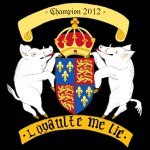
To all fans of Mr. Armitage, I need not introduce Servetus and her blog Me+Richard Armitage.
Her witty, thoughtful and thought-provoking articles, comments and examinations of fandom in all varieties and forms, is such an entertaining and addictive read that (Psst…, I must reveal it, I just can’t keep it a secret) she had 1.000.000 hits on her blog lately. If that is not a reason to celebRAte, especially during the KRA Week?
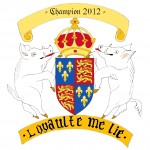
CongRAtulations, Servetus !
She posts about King Richard III and Richard Armitage each day of the event week, varying from historic to funny.
We have linked to her posts in the daily news (and I must give you a further recommendation – watch out for her tips to solve the scavenger hunt questions!):
Day 5 Quiz Tips
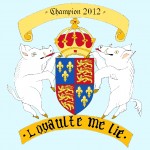
As creator of these wonderful quiz questions, she is allowed to do that. So Servetus is not only our blogger of the day, but also our quizmaster of the KRA Week 2012.
Her questions are tough, but a real champion can’t be determined by too easy questions, can he/she?
As I check the incoming results, I can further reveal, we have some who are on a really good way to become our KRA Champion 2012 !
And should I also reveal a bit about our price for the Champion? – As the final form depends a bit on the choice of the winner, we had not posted images of the price so far. We wanted to make it a badge of honour, the name of the winner will be added to one of the images on the side and the image put on a magnet, button or T-shirt, so the winner can choose what he/she prefers as a price and where best to show his/her championship.
Further articles by Servetus:
She recomments how best to Spend our Money! ?
Servetus’ analysis of a KRA-fangirl’s mind is one further example of her exceptional examinations! – Richard III won’t make me squee. Right?
And I must also reveal, Servetus gives tips and hints in her latest post to help with solving the quiz questions, so a look at all her latest posts is quite helpful, if you need tips for the scavenger hunt.
♕ Further News of the Day ♕
- ITV – report with video coverage of the location and beginning of the digging in Leicester. Please follow the link to find more details and a video report about the start of the digging here at the website of ITV:
- As the question about the sisters of King Richard III and their descendants occured in the comments, here a link to a detailed family tree of the Plantagenets.
- CDoart – as pacifist recommends the book by Mike Ingram about the Battle of Bosworth (2012)
♛ Scavenger Hunt ♛
Questions of Day 1, Day 2, Day 3 and Day 4 are online now.
- The Richard III Foundation, Inc. sponsors a free conference ticket!
Free entry to their King Richard III Conference on 13th of October 2012. – More details and program of the conference here.
TIP for the scavenger hunt:
To make back-solving of the answers easier for you, all the solution letters arranged in the right order will result in a Solution Sentence.
The form with the right order for the letters can be reached here – or can be printed/downloaded via this pdf-file.
KRA Week – Day 3
♕ ♛ ♕
Before Day 3 informations start, here are the main sites, the KRA Week 2012 and the scavenger hunt.
♕ Maria Grazia (Fly High!) ♕
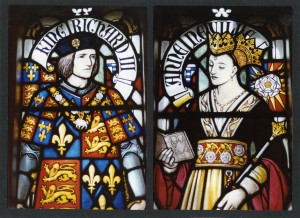
RIII and Queen Anne Neville – Stained glass window at Cardiff Castle
(Source: Geoff Wheeler, Richard III Society)
Maria Grazia with her well established blog Fly High! publishes wonderful book reviews and is a great supporter of King Richard III.
We have mentioned her articles repeatedly, so when you do a search for her here on the KRA website, you will find a full list of results.
We also had an interview with Maria Grazia here on KRA, which shows her well informed approach towards the history and literary perception of King Richard III and her full list of articles, she already has published about King Richard III. Those articles can be reached via this page on her blog Fly High!
Today, Maria Grazia presents the news of the day about the archaeological search for the mortal remains of King Richard III in Leicester, and reviews the historical novel
“Some Touch of Pity” by Rhoda Edwards
Enjoy the review and I am sure, after reading it, you will try to get a hold of this book as well.
♕ Further News of the Day ♕
- The archaeological search for the burrial place of King Richard III in Leicester will be launched TODAY! So watch out for the news coverage on BBC and BBC Breakfast !
News also is posted here on the KRA page “Search for King Richard“
- Servetus (Me + Richard Armitage) – Richard III won’t make me squee. Right? Servetus in her exceptional and unique way examines the mind and reasoning of a real KRA-fangirl
- CDoart – and the Last Days of Richard III
♕ TV-Documentation – King Richard III ♕
The TV-Documentation about King Richard III needs our help
Please support a filming of a documentation about King Richard III TODAY.
Take 2 minutes and voice your opinion today and tomorrow, on Friday 24th and Saturday 25th of August, 2012 (U.K. time), to convince Channel 4 that it is a necessary endeavour and lots of people are already waiting for a documentation about King Richard III and his life, which will take into account all the new research results and finally bring some of the mis-constructions about this English king to an end.
You can put your comment here, to show your support:
http://www.channel4.com/4viewers/contact-us
Thank you !!!
♛ Scavenger Hunt ♛
Questions of Day 1, Day 2 and Day 3 are online now.
- The Richard III Foundation, Inc. sponsors a free conference ticket!
Free entry to their King Richard III Conference on 13th of October 2012. – More details and program of the conference here.
TIP for the scavenger hunt:
To make back-solving of the answers easier for you, all the solution letters arranged in the right order will result in a Solution Sentence.
The form with the right order for the letters can be reached here – or can be printed/downloaded via this pdf-file.
KRA Week – Day 2
♕ ♛ ♕
Before we begin with day 2, here it the main site of the KRA Week 2012 and the scavenger hunt.
♕ Phylly’s Faves ♕
Phylly is a well known blogger in the fan community, always bringing in very special angles to a topic or research.
Her last year’s article during the King Richard Week can be found here (Richard, King of Hearts) and is a real reading tip (!).
It is a wonderful review of the theatre history of King Richard III and Phylly discovers quite a change in the way King Richard III is played and interpreted in different Shakespeare versions on stage with lots of entertaining video-examples.
This year, she created a birthday list for August 22nd, 2012, where King Richard III has an (accidental ?) appearance.
A nice way to show, why we ‘celebrate’ and not only commemorate King Richard III in our KRA Week.
♕ Further News of the Day ♕
- Servetus (Me + Richard Armitage) – Spend our Money! – Explains the details behind our scavenger hunt and charity procedure to get our money to the charity the winner choses.
- Fabolaktuko (WhiteRoseWriting) – Come play with us! – Fabolaktuko shows that if you don’t want to spend our money, you still can ‘play with us’ and have fun!
- CDoart – Reviews a filmed documentation about the “Wars of the Roses” (1994)
- TV-tip: Try to keep your eyes out for the BBC news and BBC Breakfast tomorrow, Friday 24th!
♕ TV-Documentation – King Richard III ♕
The TV-Documentation about King Richard III needs our help
Please support a filming of a documentation about King Richard III.
Take 2 minutes and voice your opinion on Friday 24th and Saturday 25th of August, 2012 (U.K. time) to convince Channel 4 that it is a necessary endeavour and lots of people are already waiting for a documentation about King Richard III and his life, which will take into account all the new research results and finally bring some of the mis-constructions about this English king to an end.
You can put your comment here, to show your support:
http://www.channel4.com/4viewers/contact-us
Thank you !!!
♛ Scavenger Hunt ♛
Questions of Day 1 and Day 2 are online now!
- The Richard III Foundation, Inc. sponsors a free conference ticket!
Free entry to their King Richard III Conference on 13th of October 2012. – More details and program of the conference here.
TIP for the scavenger hunt:
To make back-solving of the answers easier for you, all the solution letters arranged in the right order will result in a Solution Sentence.
The form with the right order for the letters can be reached here – or can be printed/downloaded via this pdf-file.
